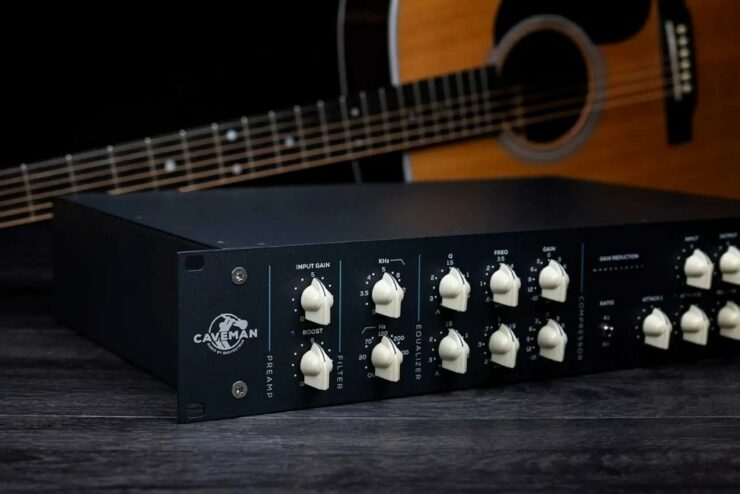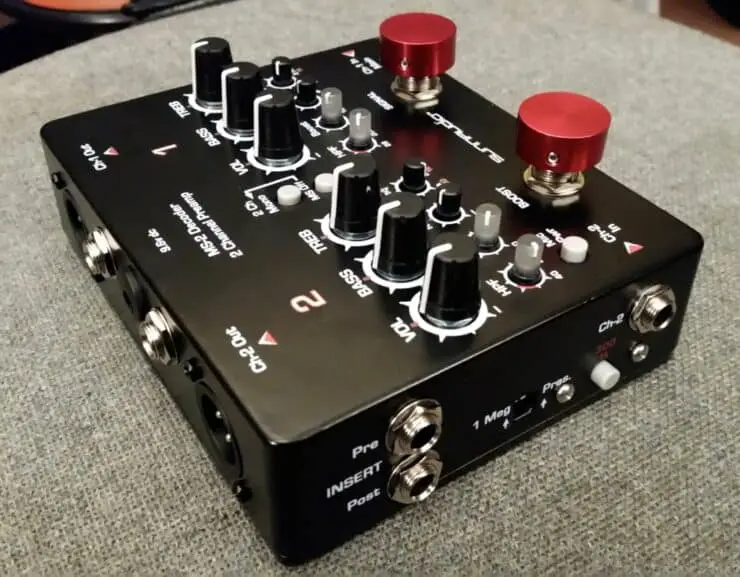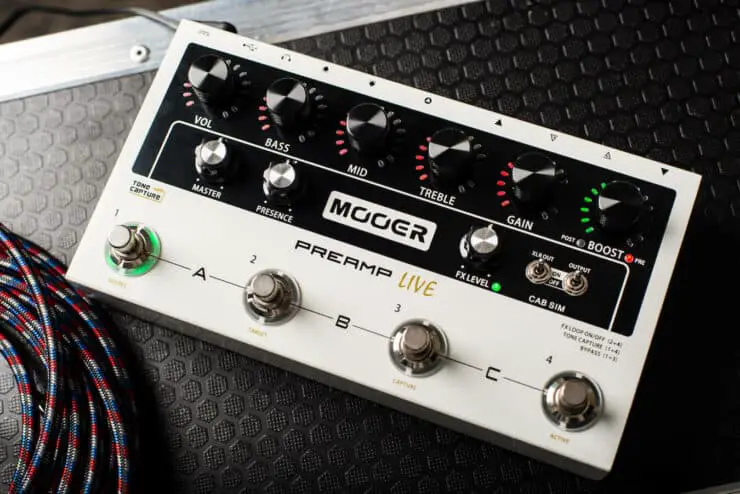Greetings fellow guitar players! Have you ever wanted to deepen your understanding of guitar preamps, but felt overwhelmed by all the technical terminology? If so, you’ve come to the right place! In this article, we’ll break down the purpose of a guitar preamp, as well as its function and benefits. So, if you’re ready to learn more, let’s get started!
How does a guitar preamp work?
A guitar preamp or preamplifier is an electronic device or circuitry designed for amplifying and shaping the weak electrical signal produced by the pickups of an electric or acoustic-electric guitar. It is responsible for boosting the signal to a level suitable for further processing, amplification, or recording.
A typical preamp consists of various components that work together to achieve its function such as gain stage, tone controls, input/audio, and more. The gain stage amplifies the weak signal from the guitar pickups to a stronger level. It makes use of transistors, tubes, or integrated circuits to boost the signal while maintaining low noise levels.
Preamps often include various tone controls for shaping the sound including volume and tone/EQ controls. Volume is used for adjusting the overall output level of the preamp. Meanwhile, Tone/EQ controls include bass, treble, mid, and presence knobs or switches. They allow you to adjust the frequency response and tonal characteristics of the guitar signal.
>>> Click here to read our review about the Top 15 Best Guitar Preamps <<<
The preamp has input jacks for connecting the guitar’s cable and output jacks to send the signal to other devices, such as power amps, audio interfaces, or mixing consoles. Some guitar preamps feature an effects loop, which allows you to insert external effects processors or pedals into the signal chain, typically after the preamp stage and before the power amp or recording device.
The preamp needs a power source to operate. This can either be a battery, an external power supply, or in some cases, it might even be powered by the amplifier it is connected to. Guitar preamps often come with additional controls and switches for features like channel selection, gain boost, phase inversion, or impedance matching.
What is the purpose of a guitar preamp?
A guitar preamp isn’t just a device for amplifying your guitar signal but it also serves as a creative powerhouse. While it might seem like a small device, it serves a wide range of features, allowing you to explore a world of sonic possibilities. By knowing what is the purpose of a guitar preamp, you’ll be able to unlock a new dimension in your playing and craft a unique sonic signature.
#1. Boosting the signal
One of the primary purposes of a guitar preamp is to amplify the guitar signal, ensuring that it reaches an optimal level before further proceeding. Boosting the signal can benefit your sound by overcoming signal loss and driving the amp.
Long cables, pedalboards, and other signal chains can sometimes result in a loss in high-frequency content and overall signal strength. A guitar preamp will allow you to compensate for these losses, ensuring a clean and robust signal.
By increasing the signal strength before it reaches the amp, a preamp can push the amp into natural tube saturation or overdrive, providing a rich, harmonic complex tone. It can be especially useful when playing at lower volumes or with more nuances playing dynamics.

#2. Adding effects
Guitar preamps often incorporate built-in effects or offer a platform for connecting external effects pedals. Adding effects through a preamp enhances the sonic palette by adding convenience, integration, flexibility, and experimentation.
Many guitar preamps come with built-in effects like delay, reverb, modulation, and more. These effects can be accessed easily and controlled from a single unit, allowing for a streamlined and efficient setup.
Connecting external effects pedals to your preamp expands your sonic possibilities exponentially. By routing your guitar signal through the preamp before the effects chain, you’ll be able to achieve unique tonal textures, creative combinations, and precise control over your effects.
#3. Enhancing tone
A guitar preamp is an important tool for shaping and enhancing your overall tone. It contributes to tonal enhancement by helping with EQ and tone shaping, harmonic enhancement, and tube emulation.
Preamps typically come with EQ controls that allow you to shape the frequency response of your guitar’s signal. Adjusting bass, treble, and midrange controls can add warmth, clarity, or presence to the tone, helping you tailor the sound to your preferences and the musical context.
Some preamps offer harmonic enhancement features that introduce subtle saturation, harmonics, or tube-like characteristic to the signal. These enhancements can add depth, richness, and complexity to the tone, making it more pleasing and expressive.
Certain preamps utilize advanced digital modeling technologies for accurately replicating the characteristics of iconic tube amps. This emulation allows you to experience the tonal qualities and responsiveness associated with vintage tube amps, even when using a solid-state or digital preamp.
#4. Equalize the guitar signal
Another important purpose of a guitar preamp is to provide equalization (EQ) capabilities, allowing you to shape the frequency response of your guitar’s signal. Equalizing the guitar signal is important as it helps with tone shaping and feedback control.
A guitar preamp typically features EQ controls like bass, treble, and midrange, allowing you to tailor the tone to your preferences and musical context. By boosting or cutting specific frequency ranges, you’ll be able to sculpt the sound to emphasize certain characteristics, enhance clarity, or add warmth.
In live performance situations, acoustic-electric guitars benefit from the preamp’s EQ capabilities to control feedback issues. By attenuating problematic frequencies, you’ll be able to mitigate feedback and achieve a more balanced and controlled sound during amplified performances.
#5. Refine the guitar’s signal
Beyond amplification and equalization, a guitar preamp also serves additional purposes to refine and enhance the guitar’s signal. This includes impedance matching, signal condition, and tone coloration.
A preamp often offers impedance matching between your guitar and the subsequent device in the signal chain, such as amps or audio interfaces. This ensures that the electrical characteristics of your guitar’s signal are correctly matched to optimize signal transfer and maintain tonal integrity.
Guitar preamp smight include circuitry to improve the overall quality of the guitar’s signal. This can involve buffering the signal to minimize impedance interactions, reducing noise and interference, and providing impedance compensation for specific pickup types.
Some guitar preamps, especially those utilizing vacuum tubes, can introduce subtle harmonic coloration and compression to the guitar’s signal. This can add depth, warmth, and vintage character to your tone, imparting a unique sonic flavor to your playing.
Different types of guitar preamp
In the realm of guitar preamps, there are different types of guitar preamps that cater to different tonal preferences and musical contexts. From the warm and harmonically rich tones of tube preamps to the reliable and versatile characteristics of solid-state preamps, and the innovative digital modeling preamps, each one will bring in a unique sonic palette to your fingertips. Here are the different types of guitar preamps available in the market, offering you insight into what they’re all about and helping you make an informed choice for your playing style and needs.
#1. Tube preamps
Tube preamps or also known as valve preamps have a long-standing reputation for their warm, organic, and harmonically rich tones. They employ vacuum tubes to amplify the guitar signal, introducing natural compression and subtle harmonic distortion. The tube’s inherent characteristics like even-order harmonics and a soft clipping nature create a pleasing and dynamic sound that many guitarists adore.
Tube preamps excel at delivering vintage, bluesy, and classic rock tones, with their responsiveness to playing dynamics and the ability to produce creamy overdrive or smooth clean sounds. However, they can be more delicate, require maintenance, and generate heat.
#2. Solid-state preamps
Solid-state preamps make use of semiconductor components like transistors to amplify the guitar signal. They are known for their reliability, durability, and clean anda transparent sound reproduction.
Solid-state preamps offer a high level of accuracy. They deliver a clear representation of your guitar’s natural tone without adding significant coloration. They are capable of producing pristine cleans, tight distortion, and defined high-gain tones. Solid-state preamps excel in genres that need tightness and precision, such as funk, metal, and modern rock. They are often favored by touring musicians due to their robust construction and consistent performance.

#3. Digital modeling preamps
Digital modeling preamps have come a long way since their introduction. These devices have truly revolutionized the guitar world by emulating the sound and characteristics of various iconic amps and effects. These preamps make use of sophisticated digital signal processing algorithms for replicating the sonic signatures of tube amps, solid-state circuits, and a wide range of vintage or modern gear.
Digital modeling preamps deliver unparalleled versatility, allowing guitarists to access an extensive collection of amp models, cabinet simulations, and effects within a single unit. They can accurately emulate the tonal nuances of classic amps or explore futuristic and experimental sonic landscapes. Digital modeling preamps are ideal for recording line performances and practice environments, offering convenience and sonic flexibility. However, some purists may argue that they might lack the exact tactile response and harmonic complexity of their analog counterparts.
#4. Hybrid preamps
Hybrid preamps combine the best analog and digital technologies, merging both tube and solid-state elements or analog and digital signal processing. These preamps aim to deliver the warmth and tonal characteristics of tubes while incorporating the flexibility and reliability of digital technology.
Hybrid preamps often feature tube-driven stages combined with digital effects, modeling capabilities, or integrated signal routing options. They offer the perfect balance between classic analog sound and modern conveniences, offering guitarists a versatile platform for tonal exploration.
How to use a guitar preamp
A guitar preamp is a powerful tool that allows you to shape your guitar’s tone and unlock a plethora of sonic possibilities. Whether you are a beginner or an experienced guitarist, understanding how to effectively use a guitar preamp will be important for achieving the desired sound. To harness the guitar preamp’s full potential, it will be important to understand the process of connecting the preamp to your amp and adjusting the settings. Here are the steps you will need to follow to set up and use a guitar preamp. This will help you maximize your guitar preamp’s potential and elevate your playing experience to a whole new level.
Step 1: Connect your preamp to the amp and set it up
First, you will need to identify the input and output ports. Locate the input and output jacks on both the preamp and the amp. The input jack on the preamp receives the guitar signal, while the output jack will send the processed signal to the amp.
Make sure that you are using the necessary cables for connecting the guitar preamp and the amplifier. Use a high-quality instrument cable for connecting your guitar to the preamp’s input jack. Then, you should use another cable, such as a ¼-inch instrument cable, for connecting the preamp’s output jack to the amp’s input jack.
Then, you need to check the signal flow. Confirm that the guitar signal flows from the guitar to the preamp’s input and from the preamp’s output to the amp’s input. This will ensure that the signal chain is correct and the preamp’s processed signal reaches the amp for proper amplification.
Now comes the time to power up. If your preamp needs power, make sure that it is properly connected to a power source. It could either be using a power adapter or through batteries according to the preamp’s specifications. Check the preamp’s power indicator for verifying that it is receiving power.

Step 2: Adjusting the preamp settings
Start off by setting the gain (also known as volume) control on the preamp. This control will determine the strength of the input signal. You should adjust it to achieve an optimal balance between a clean signal and the desired amount of overdrive or distortion.
Most preamps tend to include tone controls such as bass, treble, and mid. These controls shape the frequency response of the guitar signal. Experiment with each control for sculpting the tone to your liking. Increase the bass for a thicker sound, adjust the midrange for presence and warmth, and tweak the treble for brightness and clarity.
Depending on your guitar preamp, there might be other controls like presence, reverb, or effects parameters. Explore these controls for further shaping your tone or adding desired effects to your sound. As you are adjusting the preamp settings, you should take ample time to experiment with different settings and listen carefully to the changes in tone. You should not be afraid to explore various combinations to find your unique sound. Consider the musical context, playing style, and genre for guiding your adjustments.
You need to match your preamp with the amp’s settings. Make sure that the amp’s settings complement your preamp settings. For instance, if your preamp adds significant gain or distortion, you might want to adjust the amp’s volume and EQ accordingly to achieve a balanced sound.
Listen attentively and make subtle adjustments to your preamp settings as required. Fine-tuning will help you achieve the desired tone, responsiveness, and dynamics that suit your playing style and musical goals.
Step 3: Recording and live performance
If you are recording with a guitar preamp, you should connect the preamp’s output to the input of your audio interface. Make sure that the levels are properly set to avoid clipping or distortion. Experiment with microphone placement and different recording techniques for capturing the best representation of your preamp’s tone.
When you are using a preamp for live performance, you should connect the preamp to your amp or PA system as outlined in the setup instructions. Fine-tune your preamp settings based on the venue, desired sound projection, and room acoustics. You should consider using footswitches or MIDI controllers to switch between preamp settings during your performance.
Benefits of a guitar preamp
When it comes to shaping the sound of an electric guitar or an acoustic-electric guitar, an important tool in a musician’s arsenal will be a guitar preamp. Serving as the initial amplification stage, a preamp offers a wide range of benefits that can elevate your playing experience and bring your sound to new heights. Here are some of the benefits of using a guitar preamp and how it can enhance your sound.
#1. Amplify the signal
The primary benefit of a guitar preamp is to boost the weak electrical signal produced by the pickups of your guitar. By increasing the signal strength, a preamp will ensure that your tone retains its clarity and dynamics throughout the signal chain.
This amplification is essential when connecting to various audio devices, including amps, audio interfaces, or mixing consoles, allowing you to achieve the desired volume levels without sacrificing quality.
#2. Tone shaping and control
One of the most significant benefits of a guitar preamp lies in its ability to shape and control your tone. With built-in tone controls, such as bass, treble, mid, and presence knobs, a preamp will allow you to fine-tune the frequency response of your guitar signal.
These adjustments will allow you to sculpt your sound to suit different musical styles, venues, or personal preferences. Whether you prefer a warm and mellow jazz tone or a punchy and aggressive rock sound, a preamp will empower you to tailor your tone with precision.
#3. Versatility and flexibility
A guitar preamp will offer remarkable versatility and flexibility in your playing setup. It can be used as a standalone unit integrated within amps or in pedal format. This versatility will allow you to easily switch between different amp systems or use multiple preamps for various tonal options.
Additionally, some preamps also feature multiple channels, allowing you to transition seamlessly between clean and overdriven sounds, expanding your creative possibilities on stage or in the studio.
#4. Integration of effects
Many guitar preamps offer an effects loop, which serves as an integration point for external effects pedals or processors. By placing effects after the preamp stage, you will be able to maintain the integrity of your tone while incorporating time-based effects, modulation, or other creative elements.
This will allow you to experiment with different effects combinations and customize your sound without compromising the core characteristics of your guitar tone.
#5. Consistency and control
Using a guitar preamp will ensure consistency in your sound across different performance scenarios. Whether you are playing in small clubs, large venues, or recording studios, the preamp will provide a reliable and consistent foundation for your tone.
It will allow you to maintain control over your sound irrespective of the quality or characteristics of the amplification system you are using. With a preamp, you will be able to achieve a consistent tonal palette that reflects your unique playing style and artistic vision.
FAQs
What is a guitar preamp?
A guitar preamp is a device that boosts the signal from a guitar before it is sent to an amplifier. It is typically used to shape and control the sound of the guitar by adding effects and adjusting the sound frequency range.
What are the benefits of using a preamp?
Using a preamp can provide several benefits, including the ability to shape and tailor the sound of the guitar to the desired tone, adding effects to the signal, and boosting the signal to an acceptable level for the amplifier. It is also useful for adjusting the volume level and improving the signal-to-noise ratio.
What should I consider when choosing a preamp?
When choosing a preamp, you should consider the type of guitar and playing style, the number and type of effects you want to add, the type of amplifier you are using, and budget. It is also important to make sure the preamp is compatible with your guitar and amplifier.



